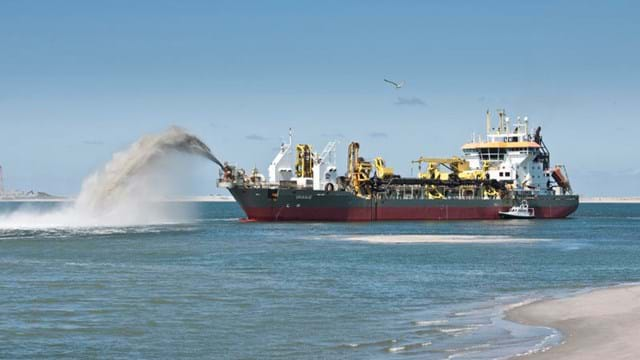The Suez Canal is one of the world’s main shipping links and thus of major importance to world trade. The canal extends from Suez on the Red Sea to Port Said on the Mediterranean. Egypt’s Suez Canal Authority awarded the contract to double the canal’s capacity to a consortium, which was aptly named the Challenge Consortium by the Chairman of the Suez Canal Authority, Admiral Mohab Mamish.
The consortium comprising Boskalis, Van Oord, NMDC (Abu Dhabi) and Jan de Nul (Belgium) had the task of dredging the 35 km long New Suez Canal parallel to the existing canal. This involved dredging a record breaking 200 million m3 of sand, clay and rock in less than 9 months. In addition, two Service Channels (80 m wide and design depth -10 m CD) and two Cross Channels (50 m wide and design depth of -6 m CD) were dredged to connect the existing canal and the New Suez Canal.
Enormous scale
Dredging 200 million m3 of material in a period of 9 months required the deployment of the world’s largest dredging fleet comprising 21 Cutter Suction Dredgers, 5 Trailing Suction Hopper Dredgers and 2 Water Injection Dredgers. The dredging vessels cut the capital volume and pumped the mixture of soil and water into 16 disposal basins totaling an area of 73 million m2. This required a total length of 85 km floating and shore pipeline.
Complex planning
To ensure the project was completed on time, the fleet of vessels had to be managed to achieve optimum production levels. The first planning task was to enable as many vessels as possible to dredge simultaneously. This required breaking in at both ends of the New Suez Canal and at four points along the existing canal to create ten fronts for the dredging vessels at an early stage in the project.
Logistics
The project was a major challenge in logistics and could have been a project on its own on managing the logistics of incoming shipments arriving on their own keel, by semi-submersible vessels, cargo vessels, and regular air freight, sea freight and road transport.
Time pressure
The main challenge for the Consortium was the time frame in which all dredging had to be completed. A project of this scale was initially estimated to take three years to complete, but the President of Egypt had set the limit for completion at one year. The period from tender to contract award was only one month, and dredging started within a month. The New Suez Canal was open for shipping in just five days after completion of the dredging works.
Facts and figures
- 35 km long canal with bottom width 147 to 177 m and design depth -24 m CD
- 2 Service Channels (width 80 m and design depth -10 m CD), and 2 Cross Channels (width 50 m and design depth -6 m CD)
- 9 months execution period including preparations
- 28 dredgers on site including 21 Cutter Suction Dredgers, 5 Trailing Suction Hopper Dredgers and 2 Water Injection Dredgers
- 85 km soil conveying pipeline (floating and shore pipeline)
- 16 disposal basins located on the east and west banks of the New Suez Canal
- Approximately 2,000 people from 45 countries employed on site; over 4.5 million man-hours, over 3,700 project safety inductions, and no fatal injuries or permanent disabilities
- The New Suez Canal was opened for shipping on 6 August 2015, 5 days after completion of dredging
- Extension of time was not possible



